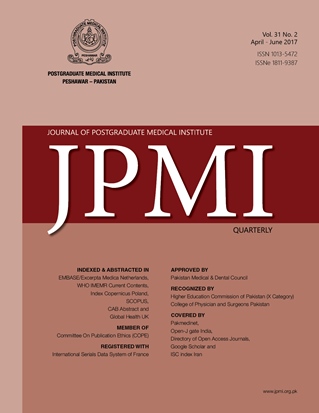CO-MORBIDITY OF SPECIFIC LEARNING DISABILITIES AND DEPRESSIVE SYMPTOMS IN NON-CLINICAL SAMPLE OF ADOLESCENTS
Main Article Content
Abstract
Objective: To determine the comorbidity and relationship between specific
learning disabilities and depressive symptoms in non-clinical sample of adolescents.
Methodology: A cross-sectional study was conducted at four government
schools of Lahore from March to December 2014. The study comprised of 287
students selected through systematic random sampling technique, age ranges
between 11 to 16 years. Demographic information questionnaire, learning
disabilities checklist and children depression inventory were administered to
obtain data. Descriptive Statistics, crosstab analysis and Pearson relationship
were applied.
Results: The mean age of 287 participants was 12.98 ±1.22 years. Overall, 56
(19.51%) of adolescents were identified with mild, 83 (28.94%) with moderate
and 40 (13.94%) with severe levels of comorbidity of depressive symptoms
and specific learning disabilities. Significant relationships between depressive
symptoms and specific learning disabilities were demonstrated (p value=.0001).
These relationships were also found significant for sample of boys whereas for
girls, only significant relationship was observed on subscale of ineffectiveness
(p value=.036)
Conclusion: Significant comorbidity of depressive symptoms and specific
learning disabilities was found. Comorbidity of severe level of depressive symptoms
and specific learning disabilities was more prevalent for sample of boys.
learning disabilities and depressive symptoms in non-clinical sample of adolescents.
Methodology: A cross-sectional study was conducted at four government
schools of Lahore from March to December 2014. The study comprised of 287
students selected through systematic random sampling technique, age ranges
between 11 to 16 years. Demographic information questionnaire, learning
disabilities checklist and children depression inventory were administered to
obtain data. Descriptive Statistics, crosstab analysis and Pearson relationship
were applied.
Results: The mean age of 287 participants was 12.98 ±1.22 years. Overall, 56
(19.51%) of adolescents were identified with mild, 83 (28.94%) with moderate
and 40 (13.94%) with severe levels of comorbidity of depressive symptoms
and specific learning disabilities. Significant relationships between depressive
symptoms and specific learning disabilities were demonstrated (p value=.0001).
These relationships were also found significant for sample of boys whereas for
girls, only significant relationship was observed on subscale of ineffectiveness
(p value=.036)
Conclusion: Significant comorbidity of depressive symptoms and specific
learning disabilities was found. Comorbidity of severe level of depressive symptoms
and specific learning disabilities was more prevalent for sample of boys.
Article Details
How to Cite
1.
Ashraf F, Najam N. CO-MORBIDITY OF SPECIFIC LEARNING DISABILITIES AND DEPRESSIVE SYMPTOMS IN NON-CLINICAL SAMPLE OF ADOLESCENTS. J Postgrad Med Inst [Internet]. 2017 May 12 [cited 2025 Dec. 5];31(2). Available from: https://jpmi.org.pk/index.php/jpmi/article/view/2018
Issue
Section
Original Article
Work published in JPMI is licensed under a
Creative Commons Attribution-NonCommercial 2.0 Generic License.
Authors are permitted and encouraged to post their work online (e.g., in institutional repositories or on their website) prior to and during the submission process, as it can lead to productive exchanges, as well as earlier and greater citation of published work.


